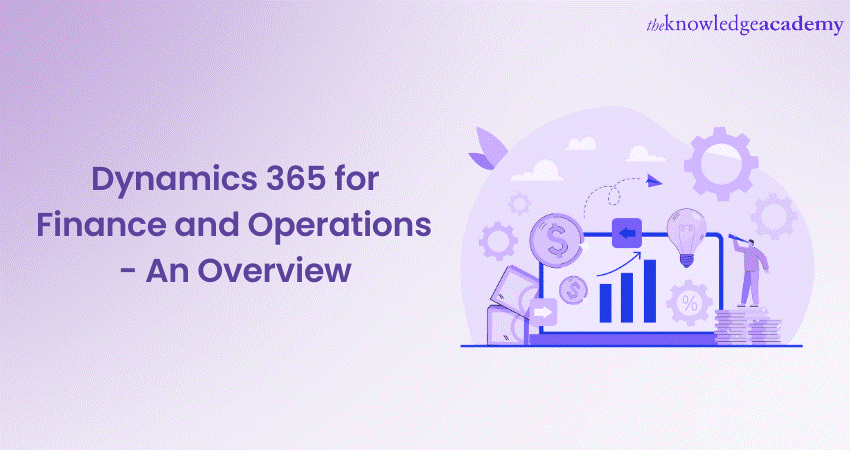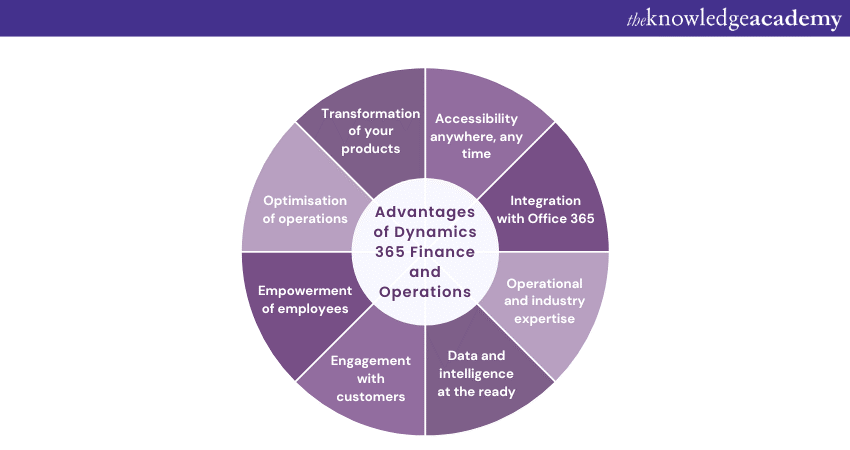We may not have the course you’re looking for. If you enquire or give us a call on 01344203999 and speak to our training experts, we may still be able to help with your training requirements.
Training Outcomes Within Your Budget!
We ensure quality, budget-alignment, and timely delivery by our expert instructors.
- Microsoft 365 Fundamentals MS900
- Microsoft Dynamics 365 Finance and Operations Apps Solution Architect MB700
- Microsoft Dynamics 365 Supply Chain Management - Functional Consultant MB330
- Microsoft Certified Dynamics 365 Supply Chain Management Functional Consultant Expert Training Course
- Microsoft Dynamics 365 Finance and Operations Apps Developer MB500

For the modern-day organisation, data is the most important resource. So, in order to get the most out of their data resources, organisations adopt Enterprise Resource Planning (ERP) systems to manage their data. ERP systems consolidate an enterprise’s planning, manufacturing, sales and marketing into one system – and help the company increase its productivity. One of the prevalent examples of ERPs is Microsoft’s Dynamics 365 Finance and Operations. This blog will tell you all you need to know about Dynamics 365 Finance and Operations, its different features as well as the advantages it provides. Read more to find out!
Table of Contents
1) What is Dynamics 365 for Finance and Operations?
2) What are the features of Dynamics 365 for Finance and Operations?
3) What are the advantages of Dynamics 365 for Finance and Operations?
4) Conclusion
What is Dynamics 365 for Finance and Operations?
Dynamics 365 Finance and Operations can be defined as a cloud-based Enterprise Resource Planning (ERP) system that is well-suited for large-scale organisations. The Microsoft-developed solution allows companies to monitor and track all their finances and inventory. Dynamics 365 helps you manage your finances and inventory and access the data you need to prepare financial statements and analyse company performances. It also facilitates easy automation of tasks to increase productivity and helps manage taxes and compliance issues. All these benefits make Dynamics 365 a prevalent finances solution.
Organisations are moving away from traditional ERP systems that take too long to implement and are too complicated to upgrade and maintain. In the digital transformation era, these businesses are shifting to modular and modern ERP platforms that create opportunities to manage their working processes more intelligently and flexibly. This is where Microsoft’s ERP solution comes in – as it unites financial and business operations across finance, supply chain, manufacturing, inventory, warehouse and transportation management with an intuitive user interface for running a modern enterprise at a global scale.

What are the features of Dynamics 365 for Finance and Operations?
The Microsoft Dynamics 365 for Finance and Operations solution has several features that can aid an organisation in improving finance team productivity, all of which we will discuss in brief as follows:
a) Global entry forms: With the increased use of the shared services model and a need to optimise human resource utilisation, the Dynamics 365 for Finance and Operations solution has taken global entry forms to the next level. Users can now seamlessly make purchase invoices for purchase orders or file in a journal entry in other entities – thus avoiding the hassle of switching between multiple legal entities or companies.
b) Exchange rate integration: Exchange rate maintenance in a global organisation is a hectic process where users need to make exchange rates every day/week/month. One must consider the possibilities of trading in different currencies, which adds complexity to the maintenance. With the Finance and Operations solution, one can now seamlessly integrate with exchange rate providers like OANDA and hence help reduce the burden on the finance/accounting teams for manually maintaining these rates.
c) Localisation: In a global ERP rollout, it is almost inevitable that statutory requirements in each country or region must be adhered to. With the Finance and Operations solution, rich out-of-the-box localisation features for the finance teams of different countries can now take control and generate reports specific to each country’s regulatory or statutory requirements.
d) Advanced bank Reconciliation: With the increased need for having accurate reconciliation between bank account statements and the ERP system, the feature of advanced bank reconciliation is one of the most important ones when it comes to increasing the finance teams’ productivity. Reconciliation often used to be a painful and tedious process where every transaction from the bank statement needed to be manually matched with every transaction, or a custom process needed to be carried out for importing the statements. With the advanced reconciliation feature available in the Finance and Operations solution, one can have globally accepted bank statement formats imported into the solution with rules defined to match by either amounts and/or dates. This feature is a huge productivity boost for finance teams.
e) In-built audit workbench: With organisations needing tighter auditing controls around duplicate vendor invoices that are entered, organisations have been learning on different systems to track high spenders, duplicate expenses and audit sample data. However, the Finance and Operations solutions facilitate additional controls and better visibility to the finance team with its in-built audit workbench feature.
f) Budget planning and control: The Finance and Operations solution has in-built capabilities that allow planning budgets with monetary and quantity-related scenarios and having different levels of workflow stages for approvals. Apart from that, one can set up tighter control on the expenditure by using budget controls for project cost control, purchasing cost control etc., ensuring better visibility into expenses and allowing one to plan better and build for the future.
g) Management reporter: By using Management Reporter – the financial reporting tool available in the Finance and Operations solution – one can configure reports per organisational requirements. With this tool, one does not need developers to develop a balance sheet or an income statement. One can also choose to have these reports run by a schedule for a week or a month, where one can view them after execution – one can also have consolidated statements created using financial reporting.
h) Aged customer balances snapshot: Back then, one had to write custom queries to look up customer ageing data cross-company. With the Finance and Operations solution’s aged balance snapshot, one can look at customers ageing in a single view across legal entities. Additionally, you can schedule a periodic job to update the aged balances, and the collections/AR team can view this in a single view based on the ageing definitions.
g) Cost accounting: With the Finance and Operations solution, cost accounting features help analyse data for various cost objects, e.g., cost centres, and allocate costs and other overheads using different measures.
h) General electronic reporting: With the introduction of what is known as the General Electronic Reporting (GER) module, finance users can now edit the elements that they would need for vendor payments, customer collections, etc., which were previously dependent on developers.
i) Cost allocations: With the features of cost allocations provided by the Finance and Operations solution, one can allocate costs based on fixed percentages or a revenue basis. One can even allocate costs across companies as intercompany transactions, which reduces the burden of having to prepare multiple journals and allocating costs accordingly.
Unlock your potential as a Finance and Operations Apps Developer by signing up for our Microsoft Dynamics 365 Finance and Operations App Developer MB500 course!
What are the advantages of Dynamics 365 for Finance and Operations?

The Dynamics 365 for Finance and Operations solution offers several advantages to an organisation’s finance and operations teams, some of which we will discuss briefly. Through implementing the Finance and Operations model, you can access the following:
1) Accessibility anywhere, any time: The Dynamics 365 for Finance and Operations solution utilises a browser-based user experience that facilitates greater mobile accessibility. This means that users can access the system from any location and on any device.
2) Integration with Office 365: The Finance and Operations solution can be integrated with Microsoft’s Office 365 package. This means that employees in your organisation can leverage the power of Dynamics 365 in their daily office tools like e-mail, spreadsheets, and word-processing documents, which allows a more productive and collaborative work culture and environment.
3) Operational and industry expertise: Being a vast network of partners who specialise in diverse industries, Microsoft can deliver an ERP that looks to the needs of a specific sector.
4) Data and intelligence at the ready: With the Dynamics 365 ERP solution as the groundwork, common processes present opportunities for integration with Big Data, Power BI, Azure IoT and Cortana Intelligence Tools.
5) Engagement with customers: As customer expectations grow daily, the Dynamics 365 ERP solution helps organisations deliver the seamless, personalised experiences that modern-day customers demand.
6) Empowerment of employees: Microsoft’s ERP solution allows an organisation to meet modern-day business demands by empowering employees with the tools necessary to work smarter, improve transparency and collaboration, and increase productivity.
7) Optimisation of operations: Dynamics 365’s ERP solution helps modern business optimise their operations and deliver excellence. It also ensures they can accelerate their growth and meet the rapidly evolving customer demands.
8) Transformation of your products: The Dynamics 365 for Finance and Operations solution also provides ample visibility into how products are used, allowing businesses to optimise their current offerings and create new ones to meet current market demands.
Want to design cutting-edge solutions as a finance and operations app architect? Register for our Microsoft Dynamics 365 Finance and Operations Apps Solution Architect MB700 course!
Conclusion
All in all, the Microsoft Dynamics 365 Finance and Operations solution offers companies the ability to monitor and keep track of all their finances and inventory. By implementing the solution, an organisation can manage their finances and inventory and implement automation in its tasks – which helps improve productivity and product quality.
Learn all about how an enterprise system helps businesses organise sales, marketing, customer service and finances by signing up for our Microsoft Dynamics 365 Training courses.
Frequently Asked Questions
Upcoming Microsoft Technical Resources Batches & Dates
Date
 Retired : Microsoft Dynamics 365 Core Finance and Operations MB300
Retired : Microsoft Dynamics 365 Core Finance and Operations MB300







 Top Rated Course
Top Rated Course


 If you wish to make any changes to your course, please
If you wish to make any changes to your course, please


